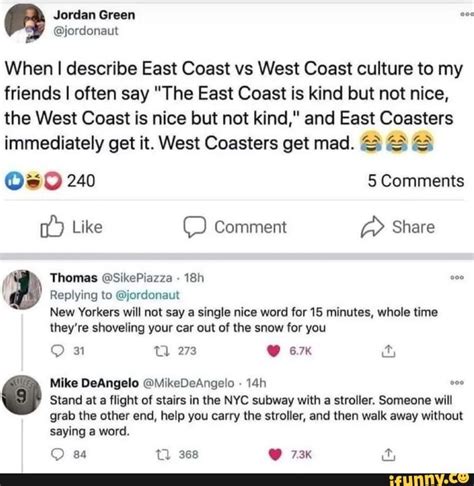Introduction
The long-standing rivalry between the East Coast and West Coast of the United States has become a cultural phenomenon. Whether it be in pop culture, politics, or even everyday interactions, the differences between these two regions are often highlighted. One of the most notable disparities lies in the perceived demeanor of their residents, with East Coasters often stereotyped as rude and hurried, while West Coasters are seen as friendly and laid-back. While these generalizations may not always hold true, there are some underlying factors that contribute to these perceptions.

Historical Context
The East Coast, home to many of the nation’s oldest cities and the original thirteen colonies, has a rich history steeped in economic and political power. This historic significance has instilled a sense of urgency and assertiveness in its inhabitants, who are accustomed to the fast-paced environment of urban centers. On the other hand, the West Coast, with its more recent settlement and emphasis on outdoor recreation, has fostered a culture that values relaxation and a slower pace of life.
Cultural Differences
The East Coast is known for its cultural diversity and cosmopolitan atmosphere. New York City, Boston, and Philadelphia are global hubs of finance, arts, and media. This diversity of perspectives has shaped the East Coast’s reputation for openness and intellectual curiosity. In contrast, the West Coast’s cultural identity is influenced by its proximity to the Pacific Ocean and its natural beauty. Cities like Los Angeles, San Francisco, and Seattle are magnets for entertainment, technology, and environmental activism. This coastal lifestyle has cultivated a more laid-back and inclusive atmosphere.
Communication Styles
The differences in cultural background and historical context have led to distinct communication styles between East Coasters and West Coasters. East Coasters are typically more direct and assertive, while West Coasters often employ a more indirect and polite approach. This difference can sometimes lead to misunderstandings, as East Coasters may perceive West Coasters as passive or evasive, while West Coasters may find East Coasters to be too aggressive or blunt.
Stereotypes vs. Reality
It is important to note that these stereotypes are just that – generalizations that may not apply to every individual. There are plenty of friendly and polite East Coasters and assertive and driven West Coasters. However, the cultural differences between the two regions do provide a framework for understanding the different ways that people from these areas interact with each other.
Benefits of Each Perspective
Both the East Coast and West Coast have their own unique strengths and benefits. The East Coast’s fast-paced, competitive environment can foster innovation and ambition, while the West Coast’s more relaxed, collaborative atmosphere encourages creativity and well-being. Embracing the best of both worlds could lead to a more balanced and fulfilling life experience.
Strategies for Bridging the Divide
To bridge the divide between East Coasters and West Coasters, it is important to:
- Be aware of cultural differences: Recognize the different communication styles and values of each region.
- Communicate respectfully: Use clear and direct language, but be mindful of tone and body language.
- Listen attentively: Pay attention to what others are saying and try to understand their perspectives.
- Be open-minded: Challenge stereotypes and be willing to learn from different ways of doing things.
Conclusion
The East Coast vs. West Coast dichotomy is a complex and multifaceted issue that has been the subject of much debate and discussion. While there are certainly differences in communication styles and cultural norms between these two regions, it is important to remember that these are just generalizations. Ultimately, it is the individuals within each region who shape its culture and reputation. By embracing the best of both worlds – the ambition of the East Coast and the laid-back nature of the West Coast – we can create a more inclusive and harmonious society.
Frequently Asked Questions
Q: Which coast is more populated?
A: The East Coast has a higher population density than the West Coast.
Q: Which coast is more expensive?
A: The East Coast, particularly the major cities, is generally more expensive to live in than the West Coast.
Q: Which coast has a better job market?
A: Both coasts have strong job markets in different sectors. The East Coast has a larger financial and media industry, while the West Coast is a hub for technology and entertainment.
Q: Which coast is more politically liberal?
A: The West Coast tends to be more politically liberal than the East Coast, particularly in urban areas.
Additional Resources
- The East Coast vs. West Coast: A Cultural Divide
- East Coast vs. West Coast: The Ultimate Culture Clash
- The East Coast-West Coast Divide: Fact or Fiction?
